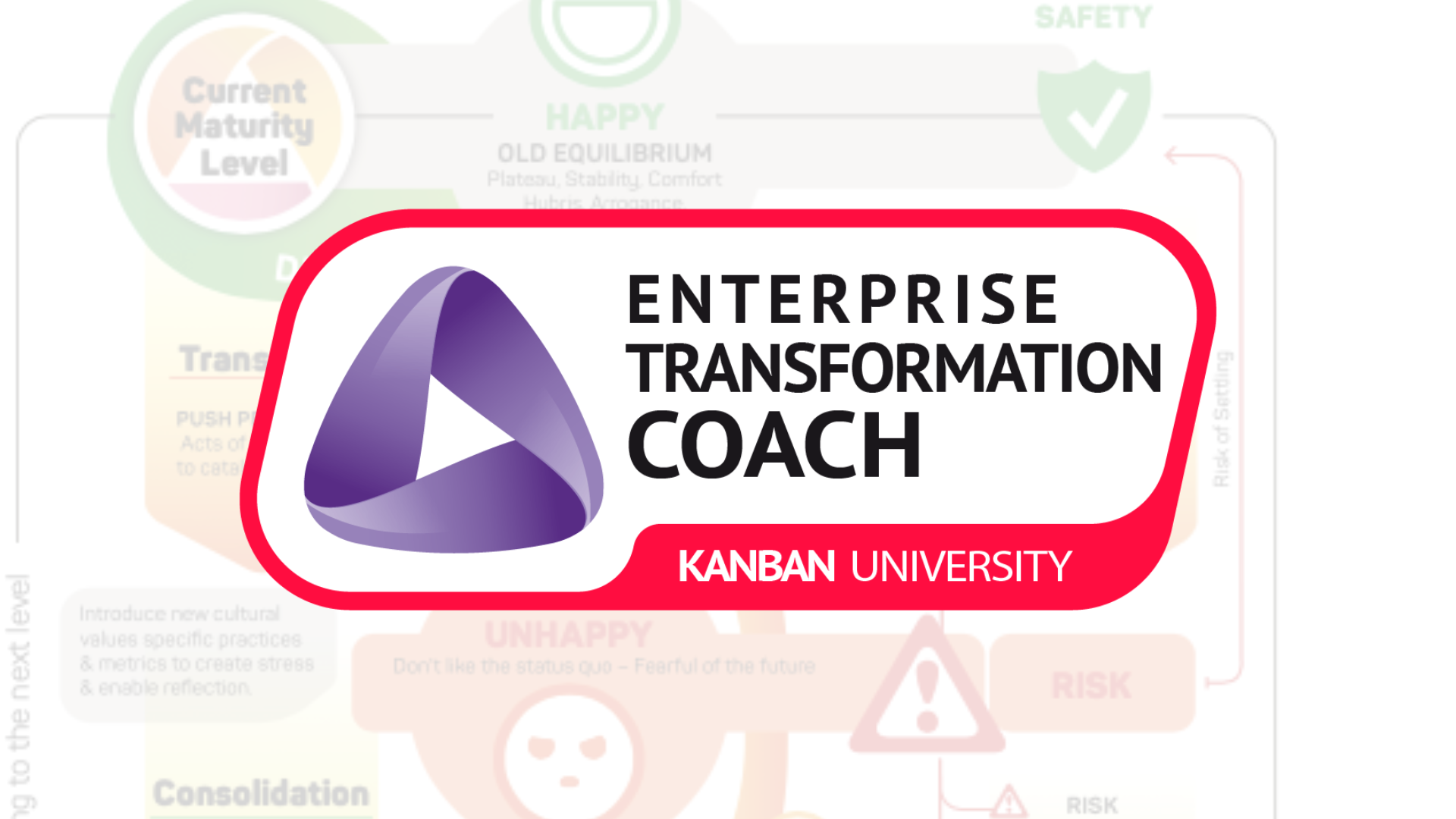New Role-based Management Credentials Arrive
At the beginning of 2025, Kanban University introduced four new training programs and professional credentials: introducing role-oriented training of Flow Manager, Delivery Manager, and Demand Manager for the first time in our almost fifteen-year history. Why have we made this switch, and why now?
Identity, Mission, and Purpose
From the beginning, Kanban University has been a management training company, focused on the professional services, intangible goods, and knowledge worker economy of the 21st century. Since the late 1970s, research by Barry Boehm has shown that poor management increased costs more rapidly than any other factor, in disciplines such as software development, systems engineering, and program management. Management training and guidance remained rooted in the early 20th century based on experience and understanding of physical, tangible goods industries such as manufacturing and distribution. Modern work was crying out for new approaches to management to improve time-to-market, service delivery times, predictability, quality, and responsiveness to changes in markets, economies, regulatory environments, political regimes, and disruptive technological innovation. Since 2003, and the publication of my first book, Agile Management, I have been focused on this mission of bringing new management methods to modern workplaces. By 2010, my approach had come to be known as the Kanban Method. And so, the mechanism to scale these ideas by delivering training to a global market came to be called Kanban University.
Shortly before his death, 20th century management expert, Peter Drucker, laid down his challenge for the 21st century. He observed that in the 20th century physical goods industries had improved their productivity by a factor 200 times. Something that cost $100 in 1900, cost the equivalent of just 50c in 2000. Drucker challenged the professional services sectors to achieve just a 50 times improvement.
Kanban University´s mission was to deliver on the hopes and aspirations of Barry Boehm and Peter Drucker to dramatically improve management in the modern workplace, to produce dramatic economic gains, that in turn would lead to meaningful social and societal change – to make a significant difference to the global economy this century by enabling the next generation of business leaders to have the credibility to lead, the confidence to act, and the knowledge and understanding to drive meaningful improvements.
Kanban
The second book, Kanban – Successful Evolutionary Change for your Technology Business, became a best seller, with over 100,000 copies in print, and available globally in 13 languages. It described the Kanban Method, an approach to improved service delivery that was designed to stick by introducing changes in an evolutionary manner, where the organization and its people owned the changes they´d introduced and change was focused on a gradual evolution – incremental improvements making a business fitter in every area of design, implementation and service delivery. The Kanban Method, when followed faithfully, created a business that is fit-for-purpose, resilient, agile, and built for survival.
The Kanban Method provided guidance on operational practices, enabling cooperation between autonomous, empowered workers to improve service delivery outcomes. At the same time, it taught managers to think in systems, to install the mechanisms to drive evolutionary change and improvement, and the management practices to enable a resilient, agile organization. The Kanban Method was rooted in the belief that installing processes and frameworks almost always failed at scale because the humans involved resisted change that affected their identity, their role in the social order, their self-esteem and social status, how they earned respect, and how they were recognized and rewarded for their contribution. To overcome this, change had to be led in an evolutionary manner, owned by those who implemented the changes, motivated by a shared purpose and a desire to contribute in a meaningful manner.
In 2011, the Kanban Method offered Kanban University the best available tool to deliver on its mission of a better way to manage modern work. The Kanban Management Professional (KMP) training program was introduced with two training classes: Kanban System Design (KSD) was oriented around the design of system of work that enabled cooperation, collaboration, empowerment and autonomy, for workers to improve service delivery outcomes – using the operational practices of the Kanban Method; the follow on class, Kanban Systems Improvement (KSI) taught the management practices that enabled the mechanism to drive evolutionary change and improvement – creating an organization wired with the DNA to survive, thrive, adapt and succeed in a world moving faster and faster.
Leadership – the magic ingredient required for success
As Kanban adoption spread around the world, a great variety of implementation variations appeared – some organizations were much more successful with Kanban than others. It became clear that the vital ingredient was leadership – there needed to be someone who took responsibility for the flow of work and accepted accountability for customer delivery. Where this was present, dramatic results were observed with productivity improvements of 4 times, sometimes as large as 20 times, and delivery times shrinking by 90% or more. Where leadership wasn´t present and didn´t emerge, the results were mediocre, lacklustre, and so much opportunity was left on the table. It became necessary to define this leadership responsibility as the service delivery manager role and recommend that these responsibilities be adopted by someone in an existing leadership or managerial role. In some organizational cultures, it became necessary to formalize the job title, either modifying an existing role or introducing a whole new one. Later it became clear that similar but slightly different responsibilities were needed upstream and these responsibilities were formalized in the definition of the service request manager role – a name chosen deliberately to reflect the needed function and not intended to replace existing job titles in upstream functions such as product owner, product manager, demand manager, account manager, etc.
In order to have the desired impact, Kanban needed leadership – to make this better understood, the leadership roles and responsibilities were formally defined. However, the general approach to training Kanban Management Professionals did not change.
Flow Manager Emerges
For many organizations, the challenges of improving management and leadership were met with significant cultural barriers, and many organizations continued to exhibit very low levels of organizational maturity, and very poor results and business outcomes. For many, just improving cooperation and moving work through their larger-scale organizations became the first step in the right direction. To make this happen, someone had to take responsibility for the flow. More and more, we saw people being asked to step up and take on the Flow Manager responsibilities. More recently, we have seen it emerge as a job title, particularly in Brazil and parts of central Europe.
In the past 5 years, we have seen these 3 roles associated with Kanban implementation and more successful adoption producing better business results: Flow Manager is a slightly degenerate form of Delivery Manager; while Request Managers are necessary where a more mature upstream workflow exists – typical of businesses that develop options, run experiments, or create multiple prototypes before committing to specific designs.
More Relatable, More Meaningful, More Personal, More Directly Applicable
Our switch to role-oriented training programs was not made without considerable thought. There was a need to make our management training more relatable to the work people do, more meaningful in terms of the benefits, and the subject areas addressed, more personal with a direct relationship to the career path and development of people pursuing a managerial career, and more directly applicable such that senior leaders sponsoring and funding the training understand how it will be used and how it might impact their business. On the other hand, the desire to avoid resistance to adoption had always come with the promise that ¨no one gets a new role, responsibilities or job title, at least initially¨. How to resolve this conflict? Kanban University had always been a management training business first, and the key enabler was to embrace that broad sense of identity rather than the much narrower concept of being the Kanban company. Rather than strict, dogmatic conformance to some historical definition of the Kanban Method, our organization can better deliver on its mission and purpose by focusing on management guidance that helps professional services businesses improve. Kanban becomes a brand that stands for better leadership, more effective management, confidence, and credibility to make decisions and take action, and a refreshingly modern approach to running modern businesses.
Descriptive not Prescriptive
The Kanban Method and derivatives such as the Kanban Maturity Model, the Fit-for-Purpose Framework, and Enterprise Services Planning have always been descriptive in nature – they have always reflected descriptions of practices and solutions that emerged in real-world situations. Kanban literature, guidance, and training have always used specific contexts and examples to describe an approach and a set of practices from which students can choose to learn, copy, adopt, and adapt. The Kanban Method has never been prescriptive – it has never mandated a formula, prescription, or framework of elements that must be present. There are no Kanban Police ensuring conformance. As such, the roles of Flow Manager, Delivery Manager, and Demand Manager have emerged in the market, and our role has been to describe them. They come with the recommendation that successful organizations have adopted the use of these roles, or at least someone in the organization has adopted the responsibilities that come with the role.
And so, the roles of Flow Manager, Delivery Manager, and Demand Manager are provided as descriptions and available as options. The new training classes define and describe these roles in a manner that reflects successful existing examples. Guidance on the adoption of roles in relation to corporate culture was published with version 1.2 of the Kanban Maturity Model and is included in the Kanban Coaching curriculum. People are free to choose whether one or more of these roles might be right for them or their organization.
Delivering on our mission
In 2025, as we start the second quarter of the 21st century, we believe that we can best advance our mission to improve the management and leadership of modern organizations through the provision of role-based training and providing role-specific credentials to individuals pursuing a management career path. We do not believe that doing so compromises our core values and beliefs, and we remain the evolutionary change company with advice, guidance, and education helping organizations improve their resilience, agility, with the evolutionary DNA to adapt, survive, and thrive in our ever faster moving world.





